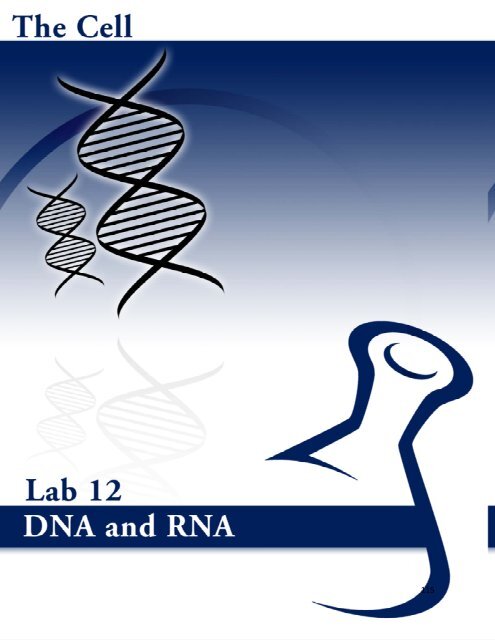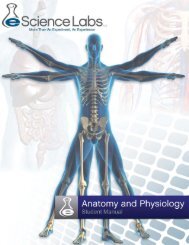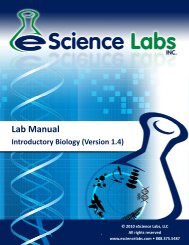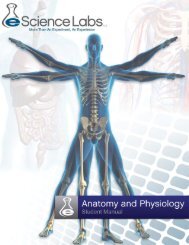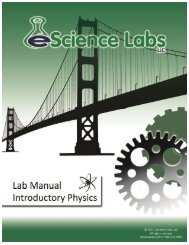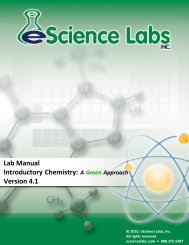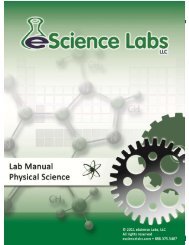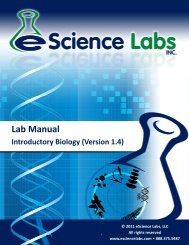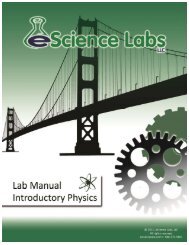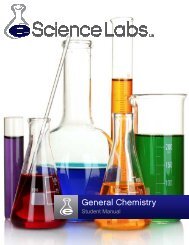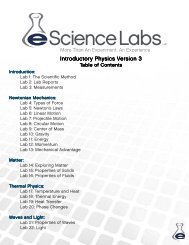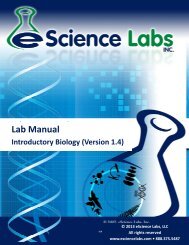Lab # 12: DNA and RNA - eScience Labs
Lab # 12: DNA and RNA - eScience Labs
Lab # 12: DNA and RNA - eScience Labs
You also want an ePaper? Increase the reach of your titles
YUMPU automatically turns print PDFs into web optimized ePapers that Google loves.
116
<strong>Lab</strong> # <strong>12</strong>: <strong>DNA</strong> <strong>and</strong> <strong>RNA</strong>As a cell divides, the <strong>DNA</strong> double helix splitsinto a single helix (Figure <strong>12</strong>.3). Each singlehelix then serves as a template for a newstr<strong>and</strong>. Neighboring nucleotides then bindto the single str<strong>and</strong> helix after which a newsugar‐phosphate backbone is formed.The nucleotides pair in such a way so thatthe two new double helices (<strong>DNA</strong>) areidentical to the original. It is the sequenceof these nucleotides that are passed on fromone generation to another, as heritableinformation.So the question remains, why is thesequence of these different 4 nucleotidesso important? Simply put, they instruct yourFigure <strong>12</strong>.3. <strong>DNA</strong> replicationcells what proteins to make <strong>and</strong> how tomake them (your body is made of protein). If the protein is wrong you are likely either very sick ordead.Proteins are simply chains of amino acids (small molecular building blocks) that are linked together.Twenty different amino acids are available to produce all the proteins in the body. Each amino acid iscoded for by a three nucleotide sequence (codon). The sequence of the amino acids determines thesize of the protein <strong>and</strong> how it will fold; both factors that determine its function. Other factors, such ascharge <strong>and</strong> hydrophobicity (an aversion to water molecules), play a role in determining how a proteinfolds.Consider the following analogy:“The earth revolves around the sun.”• Each of the <strong>12</strong> different letters (codons) in the preceding sentence is largely uninformative.• When letters are assembled they create words, which have meaning.• Linked words create a sentence (protein), which is then informative.Consider a protein that is five amino acids long. Picking from the 20 available amino acids there are 5 20different possible combinations (3,200,000). Even small proteins are typically several hundred aminoacids long. The number of different proteins that can ultimately be coded for by 20 amino acids isvirtually limitless.The next obvious question is how do the four nucleotides “code” for 20 different amino acids.Each “letter” (codon) in the genetic code is made up of three nucleotides which codes for a specificamino acid.If we start with four possible nucleotides (A, T, G, C), how does your body make twenty different aminoacids?If the “letter” is two nucleotides long, there are 16 possible “letters” (2 4 ) ‐ not enough.If the “letter” is three nucleotides long, there are 64 possible combinations (3 4 ) ‐ more than what’sneeded for twenty amino acids.
<strong>Lab</strong> # <strong>12</strong>: <strong>DNA</strong> <strong>and</strong> <strong>RNA</strong>Like a sentence, the reader (a cell) needs to know where to start <strong>and</strong> where to stop (two more codons,for a total of 21). The first codon, the start, also codes for methionine).The remaining 42 possible combinations make up what is referred to as “the redundancy of the code”.In other words, Tim, Tom, <strong>and</strong> Tam would all be the same person. It is simply three different spellingsfor his name. Each combination of three nucleotides is known as a “codon”.Experimental ProtocolMaterials Needed:Red, blue, yellow <strong>and</strong> green beadsProcedure: <strong>DNA</strong> StructureFor the following exercises:Regular beads are used as nucleotidesPop it beads are used as amino acids1. Using red, blue, yellow <strong>and</strong> green beads, devise <strong>and</strong> lay out a three color code for each of thefollowing letters (codon). For example Z = green:red:green.In the spaces below the letter, record your “code”.C: E: H: I: K: L:_ _ _ _ _ _ _ _ _ _ _ _ _ _ _ _ _ _M: O: S: T: U:_ _ _ _ _ _ _ _ _ _ _ _ _ _ _Create codons for: Start: Stop: Space:_ _ _ _ _ _ _ _ _2. Using this code, align the beads corresponding to the appropriate letter to write the followingsentence (don’t forget start, space <strong>and</strong> stop):The mouse likes most cheeseA. How many beads did you use?There are multiple ways your cells can read a sequence of <strong>DNA</strong> <strong>and</strong> build slightlydifferent proteins from the same str<strong>and</strong>. As an illustration of this “alternatesplicing”, remove codons (beads) 52‐66 from your sentence above.B. What does the sentence say now? (re‐read the entire sentence)Mutations are simply changes in the sequence of nucleotides. There are three ways this occurs:Change one, remove one, or add one
<strong>Lab</strong> # <strong>12</strong>: <strong>DNA</strong> <strong>and</strong> <strong>RNA</strong>Using the sentence from exercise 1B:3. Change the 24 th bead to a different color.A. What does the sentence say now? (re‐read the entire sentence)B. Does it make sense?4. Replace the 24 th bead <strong>and</strong> remove the 20 th bead (remember what was there).A. What does the sentence say (re‐read the entire sentence)?B. Does it make sense?C. Where does it make sense?5. Replace the 20 th bead <strong>and</strong> add one between 50 & 51.A. What does the sentence say?B. Does it make sense?C. In “C” we mutated one letter. What role do you think the redundancyof the genetic code plays, in light of this change?D. Based on your observations, why do you suppose the mutations we madein “D” <strong>and</strong> “E” are called frame shift mutations.E. Which mutations do you suspect have the greatest consequence?Why?<strong>DNA</strong> codes for all of the proteins manufactured by any organism (including you). It is valuable, highlyinformative <strong>and</strong> securely protected in the nucleus of every cell.


